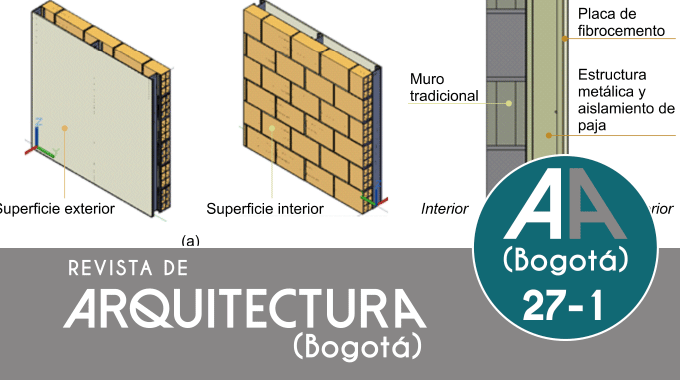

This work is licensed under a Creative Commons Attribution-NonCommercial 4.0 International License.
Revista de Arquitectura is an open access journal. More information...
Authors retain copyright and grant to the Revista de Arquitectura the right of first publication, which will be simultaneously subject to the Creative Commons (CC) BY-NC license.
Authors will sign a non-exclusive distribution license for the published version of the article by completing (RevArq FP03 Permission to Reproduce).
Self-archiving will comply with SHERPA/RoMEO guidelines and the Green classification.
To see in detail these guidelines, please consult...
Abstract
The exploration of materials and existing products new applications for construction is a strategy to add value to traditional systems. The purpose of this research is to estimate thermal performance of fiber cement and straw plates implementation as insulation construction systems in traditional stoneware and concrete walls. The methodology is experimental and it is divided into two parts: system design and heat transfer analysis. First, design explores 4 types of exterior insulation and 4 types of interior insulation made up of fiber cement plates and straw in walls with concrete blocks and fired clay blocks. Secondly, the heat transfer analysis determines the thermal transmittance, temperature distribution, heat fluxes through ANSYS calculations and simulations. The results indicate that the most efficient insulation is made with fiber cement plate because they reduce transmittance between 50.50 % and 63.59 % and reduce the temperatures of interior surfaces between 13.61 °C and 14.33 °C. On the other hand, the typologies with fiber cement plate and straw improve transmittance to a lesser extent, between 36.41 % and 49.46 %, and reduce interior temperatures by around 7 °C, compared to traditional walls. Ultimately, the cladding system dampens heat transfer in concrete block and fired clay walls.

References
Atsonios, I., Mandilaras, I., & Founti, M. (2019). Thermal assessment of a novel drywall system insulated with VIPs. Energies, 12(12), 2373. https://doi.org/10.3390/en12122373
Cengel, Y. (2007). Transferencia de calor y masa, un enfoque práctico (4ta. Ed.). McGraw-Hill Interamericana Editores S. A.
Centro de Investigación en Salud Integral y Bienestar Socioeconómico (CISBE). (2007). Thermal properties of building structures Guide A: Environmental Design
Chen Austin, M., Castillo, M., Carrizo, K., de Mendes Da Silva, Ángela, & Mora, D. (2021). Evaluación del rendimiento térmico y estrategias bioclimáticas de un edificio Universitario en clima tropical húmedo. Revista De Iniciación Científica, 7(1), 16-23. https://doi.org/10.33412/rev-ric.v7.1.3048
Colmenares Uribe, A., Díaz Fuentes, C., Sánchez-Molina, J., & Sánchez Zúñiga, J. (2023). El diseño de producto cerámico como estrategia de mitigación de transferencia de calor en envolventes arquitectónicas. Ecoe Ediciones S.A.S.
Consejo Colombiano de la Construcción Sostenible (CCCS). (2021). Estado de la construcción sostenible en Colombia 2021. https://www.cccs.org.co/wp/
Díaz Fuentes, C. X., Mancilla, J. J. , & Pérez, M. C. (2020). Physical-thermal straw properties advantages in the design of a sustainable panel-type construction system to be used as an architectural dividing element. Journal of Physics: Conference Series, 1587, 012032. https://doi.org/10.1088/1742-6596/1587/1/012032
Departamento Administrativo Nacional de Estadística (DANE). (2021). Boletín técnico de censo de edificaciones (CEED). DANE.
Díaz-Fuentes, C., Granados Peñaranda, M., & Sánchez-Molina, J. (2021a). Aplicación de la cerámica en la arquitectura. Ecoe Ediciones.
Díaz-Fuentes, C. X., Ríos-Cruz, S. A., & Cano-Macías, S. A. (2021b). Análisis comparativo de las propiedades térmicas y mecánicas de bloques de paja y tierra compactada versus sistemas constructivos de mampostería tradicional. Mundo FESC, 11(s4), 96-109. https://doi.org/10.61799/2216-0388.943
EURONIT Fachadas y cubiertas. (2006). Ficha de información del producto de placa de construcción de Eterboard HD. https://www.euronit.es/es-es/.
González-Cruz, E. M. (2021). Selección de materiales en la concepción arquitectónica bioclimática. Instituto de Investigaciones de la Facultad de Arquitectura y Diseño (IFAD). Universidad del Zulia.
Gobierno de Colombia. (2019). Estrategia nacional de economía circular. Cierre de ciclos de materiales. Presidencia de la República, Ministerio de Ambiente y Desarrollo Sostenible, Ministerio de Comercio, Industria y Turismo. http://www.andi.com.co/Uploads/Estrategia %20Nacional %20de %20EconA %CC %83 %C2 %B3mia %20Circular-2019 %20Final.pdf_637176135049017259.pdf
Instituto de Hidrología, Meteorología y Estudios Ambientales (IDEAM). (2010). Atlas interactivo de Colombia. IDEAM.
Martín Domingo, A. (2018). Apuntes de transmisión del calor. Creative Commons.
Ministerio de Vivienda, Ciudad y Territorio. (2015). Guía para el ahorro de agua y energía en edificaciones. Resolución 549 de 2015. Ministerio de Vivienda, Ciudad y Territorio
Narváez-Ortega, M. S., Sánchez-Molina, J., & Sánchez-Zúñiga, J. V. (2021). Diseño de producto cerámico de baja transmitancia térmica para sistemas de mampostería en clima cálido tropical. Mundo FESC, 11(S5), 282-291.
Pásztory, Z., & Hung Anh, L. D. (2021). An overview of factors influencing thermal conductivity of building insulation materials. Journal of Building Engineering, 44, 102604. https://doi.org/10.1016/j.jobe.2021.102604
Pérez, J. B., Cabanillas, R. E., Hinojosa, J. F., & Borbón, A. C. (2011). Estudio numérico de la resistencia térmica en muros de bloques de concreto hueco con aislamiento térmico. Información tecnológica, 22(3), 27-38. http://dx.doi.org/10.4067/S0718-07642011000300005
Portafolio. (2022). Edificaciones impulsan el PIB de construcción en este año. https://www.portafolio.co/economia/edificaciones-impulsan-el-pib-de-construccion-en-este-ano-566580
Sánchez-Molina, J., Corpas Iglesias, F., & Álvarez Rozo, D. (2018). Aplicaciones de los nutrientes tecnológicos en la industria cerámica del área metropolitana de Cúcuta. Ecoe Ediciones.
Sánchez-Molina, J., González Mendoza, J., & Avendaño Castro, W. (2019). El clúster cerámico apuesta de desarrollo socioeconómico de Norte de Santander. Ecoe Ediciones.
Sánchez-Molina, J., Díaz-Fuentes, C. X., & Colmenares-Uribe, A. P. (2021, july). Utilization of agro-industrial waste to improve thermal behavior of products made of fired clay for traditional masonry. Journal of Physics: Conference Series, 1981(1), 012015.
Torres, B., Viñachi, J., Cusquillo, J., Pazmiño, C., & Segarra, M. (2019). Aprovechamiento de la arquitectura pasiva para la reducción de carga térmica por ganancia solar en un edificio de la Facultad de Arquitectura de la Universidad de Guayaquil. Extensionismo, Innovación y Transferencia Tecnológica, 5, 378-388.
United Nations. (2023). Sustainable development goals report 2023: Special edition. New York: United Nations Publications.
Vélez Pareja, E. A. (2015). Caracterización del comportamiento térmico de materiales constructivos usados comúnmente en Colombia para la construcción de envolventes de edificaciones. Universidad del Norte, Colombia. http://hdl.handle.net/10584/9023
Wieser, M., Onnis, S., y Meli, G. (2020). Desempeño térmico de cerramientos de tierra alivianada : posibilidades de aplicación en el territorio peruano. Revista de Arquitectura (Bogotá), 22(1), 164–174. https://doi.org/10.14718/RevArq.2020.2633
































